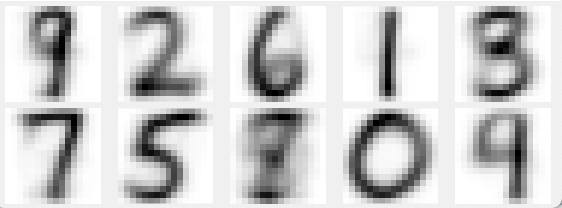Next: Self-Organizing Map (SOM) Up: ch10 Previous: Autoencoder
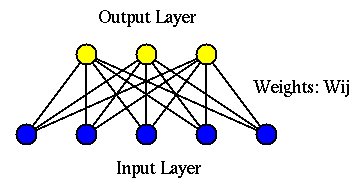
Competitive learning is a neural network algorithm for unsupervised
clustering, similar to the K-means algorithm considered previously.
The competitive learning takes place in a two-layer network composed
of an input layer of 
![${\bf x}=[x_1,\cdots,x_d]^T$](img44.svg)

![${\bf y}=[y_1,\cdots,y_m]^T$](img46.svg)


In each iteration of the learning process, a pattern 
![${\bf X}=[{\bf x}_1,\cdots,{\bf x}_N]$](img121.svg)



 |
(76) |
 is the angle between vectors
is the angle between vectors  and
and  in the d-dimensinal feature space. If the data vectors are optionally
normalized with unit length
in the d-dimensinal feature space. If the data vectors are optionally
normalized with unit length
 , i.e., they are points
on the unit hypersphere in the space. Optionally if the weight vectors
, i.e., they are points
on the unit hypersphere in the space. Optionally if the weight vectors
 is also normalized with
is also normalized with
 , then their inner
product above is only affected by the angle
, then their inner
product above is only affected by the angle  between them.
between them.
The output of the network is determined by a winner-take-all competition. The node in the output layer that is maximally activated will output 1 while all others output 0:
 |
(77) |
 is closely related to the
Euclidean distance
is closely related to the
Euclidean distance
 :
:
 |
 |
 |
|
 |
 |
(78) |
 and
and  are normalized, the winning node
with the maximum activation
are normalized, the winning node
with the maximum activation
 also has the
minimum Euclidean distance
also has the
minimum Euclidean distance
 and anglular
distance
and anglular
distance  . Therefore the competition above can also be
expressed as the following:
. Therefore the competition above can also be
expressed as the following:
 |
(79) |
 |
(80) |
 is the learning rate (step size). Optionally the
new weight vector can also be renormalized. For the iteration
process to gradually approach a stable clustering result, the
learning rate
is the learning rate (step size). Optionally the
new weight vector can also be renormalized. For the iteration
process to gradually approach a stable clustering result, the
learning rate  needs to be reduced through the iterations
from its initial value (e.g.,
needs to be reduced through the iterations
from its initial value (e.g.,
 ) toward 0 by a certain
decay factor
) toward 0 by a certain
decay factor  (e.g.,
(e.g.,
 ). This way the learning
rate decays exponentially for the learning process to gradually
slow down and becomes stabalized. The decay factor
). This way the learning
rate decays exponentially for the learning process to gradually
slow down and becomes stabalized. The decay factor  depends
on the size of the dataset, and it may need to be determined
heuristically and experimentally.
depends
on the size of the dataset, and it may need to be determined
heuristically and experimentally.
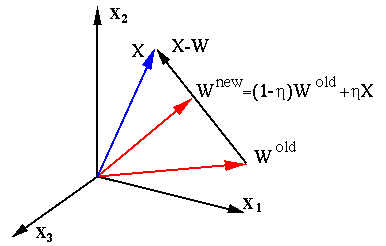
The competitive learing is illustrated in the figure above, where
the modified weight vector of the winner




Here are the iterative steps in the competitive learning:
 , initialize
randomly the weight vectors
, initialize
randomly the weight vectors  for the output nodes
(e.g., any
for the output nodes
(e.g., any  randomly chosen samples from the dataset):
randomly chosen samples from the dataset):
 , set
iteration index to zero
, set
iteration index to zero  ;
;
 from the
dataset and calculate the activation for each of the output nodes:
from the
dataset and calculate the activation for each of the output nodes:
 |
(81) |
 ,
and update its weights:
,
and update its weights:
 |
(82) |
 .
Optionally, renormalize
.
Optionally, renormalize
 .
.
 is reduced from
its initial value
is reduced from
its initial value  to some small value (e.g., 0.1) and the
weight vectors no longer change significantly. Otherwise
to some small value (e.g., 0.1) and the
weight vectors no longer change significantly. Otherwise
 , go back to Step 1.
, go back to Step 1.
This iterative process can be more intuitively understood as shown
in the figure below. Every time a sample 





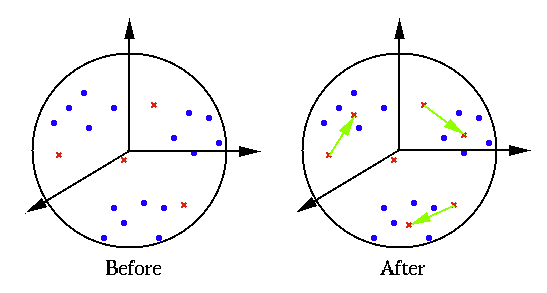
It is possible in some cases that the data samples are not distributed in such a way that they form a set of clearly saperable clusters the feature space. In the extreme case, they may even form a continuum. In such cases, a small number of output nodes (possibly even just one) may become frequent winners, while others become “dead nodes” if they never win and consequently never get the chance to odify their weight vectors. To avoid such meaningless outcome, a mechanism is needed to ensure that all nodes have some chance to win. This can be implemented by including an extra bias term in the learning rule:
 |
(83) |
 is the bias term proportional to the difference between
the “fair share” of winning
is the bias term proportional to the difference between
the “fair share” of winning  and the actual winning frequency:
and the actual winning frequency:
 |
(84) |
 for the ith node will change its
winning frequency. If the node is winning more than its share
for the ith node will change its
winning frequency. If the node is winning more than its share  ,
then
,
then  and it becomes harder for it to win in the future. On
the other hand, if the node rarely wins,
and it becomes harder for it to win in the future. On
the other hand, if the node rarely wins,  and its chance to win
in the future is increased. Here hyperparameter
and its chance to win
in the future is increased. Here hyperparameter  is some scaling
coefficient. The greater
is some scaling
coefficient. The greater  , the more balanced the competition will
be. It needs to be fine tuned based on the specific nature of the
data being analyzed.
, the more balanced the competition will
be. It needs to be fine tuned based on the specific nature of the
data being analyzed.
This process of competitive learning can also be viewed as a
vector quantization process, by which the continuous vector
space is quantized to become a set of 




The Matlab code for the iteration loop of the algorithm is listed below.
[d N]=size(X); % dataset containing N samples
b=zeros(1,K); % bias terms for K clusters
freq=zeros(1,K); % winning frequencies
eta=0.9; % initial learning rate
decay=0.99; % decay rate
it=0;
while eta>0.1 % main iterations
it=it+1;
W0=W; % initial weight vectors
x=X(:,randi(N,1)); % randomly select an input sample
dmin=inf;
for k=1:K % find winner among all K output nodes
d=norm(x-W(:,k))-b(k);
if dmin>d
dmin=d; m=k; % mth node is the winner
end
end
w=W(:,m)+eta*(x-W(:,m)); % modify winner's weights
W(:,m)=w/norm(w); % renormalize its weights (optional)
share(m)=share(m)+1; % update share for winner
b=c*(1/K-share/it); % modify biases for all nodes
eta=eta*decay; % reduce learning rate
end
Examples
The competitive learning method is applied to a set of simulated 2-D
data of four clusters. The network has 




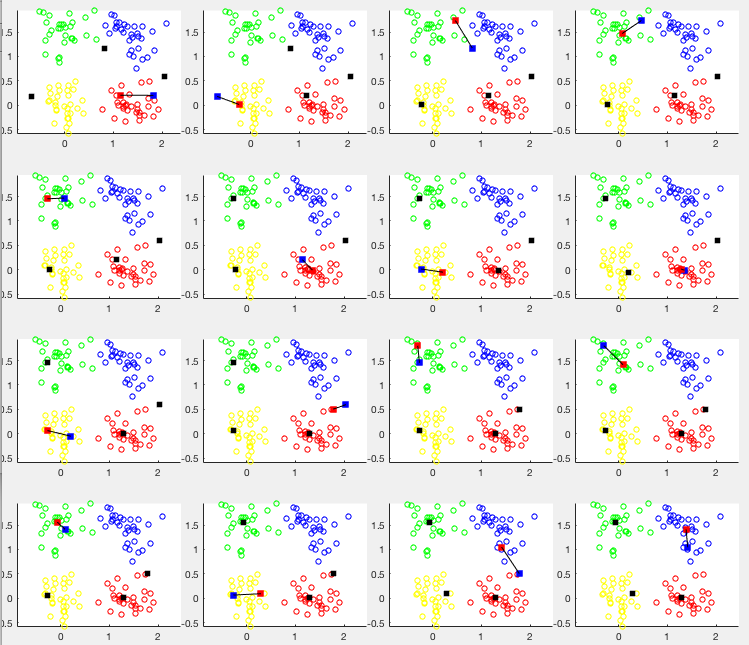
The same method is applied to a set of 3-D data of eight clusters. The results are shown in the figure below, where the top and bottom rows show the data and weight vectors before and after clustering, respectively. The left column shows the 2-D space spanned by the first two principal components, while the right column shows the original 2-D space. Again we see that the weight vectors move from their random initial locations to the centers of the eight clusters as the result of the clustering.
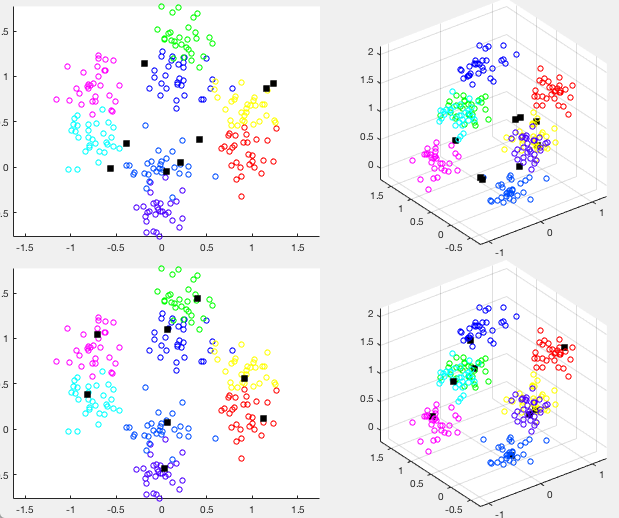
The competitive learning algorithm is also applied to the dataset of
handwritten digits from 0 to 9, and the clustering result is shown
as the average of all samples in each cluster in

